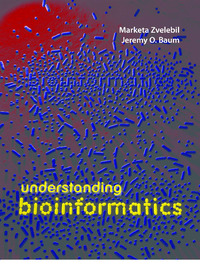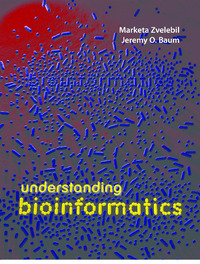- Έκδοση
- Βιβλίο έντυπο
- Zvelebil, Marketa J. | Baum, Jeremy O.
- First edition
- Marketa Zvelebil & Jeremy O. Baum
-
New York City,
London:
Garland Science, 2008
- xxiii, 772 pages : illustration (chiefly color), tables ; 28 cm.
- 9780815340249 (paperback)., 0815340249 (paperback).
- Includes bibliographical references and index.
- Original: Βιβλιοθήκη Πανεπιστημίου Κύπρου . - Rules: RDA
-
-
The book is divided into seven parts, with the Part 1 introducing the basics of nucleic acids, proteins and databases. Subsequent parts are innovatively divided into "Applications" and "Theory" Chapters, allowing readers to focus their attention more effectively. In each part, the Applications Chapter provides a fast and straightforward route to understanding the main concepts and using the applications for analysis. Each of these is then followed by Theory Chapters which give greater detail and present the underlying mathematics.
Part 1, Background Basics (Ch 1-3)
The opening chapters introduce the raw material of bioinformatics: nucleic acid sequences, proteins and databases.Part 2, Sequence Alignments (Ch 4-6)
The applications chapter shows the reader how to produce and analyse sequence alignments, while the following two theory chapters look more closely at the more advanced techniques and mathematical algorithms involved.Part 3, Evolutionary Processes (Ch 7-8)
The applications chapter guides the reader through the process of recovering evolutionary history from the DNA data; the theory chapter gives detailed information on how to construct a phylogenetic tree.Part 4, Genome Characteristics (Ch 9-10)
The basics of gene prediction are covered in the applications chapter, while the theory chapter elaborates on the basic, and the more advanced, techniques.Part 5, Secondary Structures (Ch 11-12)
The book’s focus turns to structural aspects of macromolecules, with the first chapter giving an overview of web-based techniques for predicting secondary structure and their application while the second chapter covers the algorithms applied in the techniques.Part 6, Tertiary Structures (Ch 13-14)
This section looks first at modeling protein tertiary structure using homology modelling, threading and ab initio modeling; the following chapter analyses structure-function relationships.Part 7, Cells and Organisms (Ch 15-17)
In the closing chapters methods for protein and gene expression are analysed, including techniques of statistical analysis and classification, and the emerging field of systems biology is introduced.
-
-
-
Suitable for advanced undergraduates and postgraduates, Understanding Bioinformatics provides a definitive guide to this vibrant and evolving discipline. The book takes a conceptual approach. It guides the reader from first principles through to an understanding of the computational techniques and the key algorithms. Understanding Bioinformatics is an invaluable companion for students from their first encounter with the subject through to more advanced studies.
The book is divided into seven parts, with the opening part introducing the basics of nucleic acids, proteins and databases. Subsequent parts are divided into 'Applications' and 'Theory' Chapters, allowing readers to focus their attention effectively. In each section, the Applications Chapter provides a fast and straightforward route to understanding the main concepts and 'getting started'. Each of these is then followed by Theory Chapters which give greater detail and present the underlying mathematics. In Part 2, Sequence Alignments, the Applications Chapter shows the reader how to get started on producing and analyzing sequence alignments, and using sequences for database searching, while the next two chapters look closely at the more advanced techniques and the mathematical algorithms involved. Part 3 covers evolutionary processes and shows how bioinformatics can be used to help build phylogenetic trees. Part 4 looks at the characteristics of whole genomes. In Parts 5 and 6 the focus turns to secondary and tertiary structure – predicting structural conformation and analysing structure-function relationships. The last part surveys methods of analyzing data from a set of genes or proteins of an organism and is rounded off with an overview of systems biology.
The writing style of Understanding Bioinformatics is notable for its clarity, while the extensive, full-color artwork has been designed to present the key concepts with simplicity and consistency. Each chapter uses mind-maps and flow diagrams to give an overview of the conceptual links within each topic.
-


